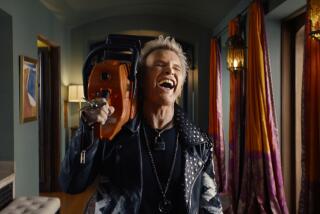The coronavirus mass shuffle in advertising: Dropped TV spots and emotional campaigns
When the novel coronavirus crisis hit the U.S., 72andSunny, one of Los Angeles’ largest creative advertising agencies, was ready.
The Playa Vista firm, which has an office in Singapore, had already watched the devastating fallout from COVID-19 in Asia.
So agency leaders in early March began arranging for staff members to work from home. And they moved swiftly with one of their biggest clients, the NFL, to spread a positive and unifying message. Unable to shoot a video, the firm asked NFL players to submit clips showing how they were coping with stay-at-home orders.
Within 48 hours, the firm had hundreds of videos, and the ad team spent three days whittling the material to a moving five-minute public-service announcement, called “Stay Home, Stay Strong.”
“We very quickly switched into the mode of: What can these brands do to bring good to the world?” said Glenn Cole, co-founder and creative chair of the agency. “Brands really have the resources and relationships in culture to make a difference.”
For advertisers who make a living by tapping into consumers’ emotions, the coronavirus has thrown a gut-wrenching curve. Less than a month ago, TV and internet commercials were filled with people mixing at parties, frolicking on a beach or gliding along city streets in a new sedan.
But almost overnight, such common activities became taboo. Advertisers spent days yanking hundreds of commercials that were suddenly cringe-worthy. Norwegian Cruise Line pulled an ad depicting families enjoying a sunny vacation with the tagline “Feel Free,” which felt awkward when hundreds of passengers were quarantined on a Princess Cruises ship.
Kentucky Fried Chicken halted a commercial in Britain that showed people sitting together, eating chicken and licking their fingers, which certainly runs afoul of prevention hygiene guidelines.
The mass shuffle came as the economy buckled, thrusting the $194-billion-a year U.S. advertising industry further into tumult. The crisis hits close to home in L.A., where many ad agencies and commercial producers are based.
Advertisers have had to quickly adapt to catastrophic events before. They did so after the Sept. 11, 2001, terrorist attacks and seven years later during the Great Recession. But the global pandemic has forced advertisers to shift gears on the fly even as they are facing an unfathomable falloff in revenue as stores, restaurants and attractions shut down, leading to staggering job losses.
Magna Global, an advertising giant, in late March revised its forecast for 2020 U.S. ad spending, noting that COVID-19 has already caused a downturn in the stock market and ejected millions of people from the workforce. Ad sales are expected to dip 2.8% this year, the firm said, noting the declines would have been worse, but an estimated $4.9 billion in political spending in the fall should cushion much of the blow.
The disruption of pilot season, which some industry vets predict may never be the same, underscores the rippling economic effects of the health crisis.
“We’re all living through very unprecedented times,” said Dawn Reese, Los Angeles-based managing director of a content studio for ad giant Universal McCann. “Messaging in the marketplace has really shifted over the last few weeks.”
The major television networks have canceled their springtime presentations to advertisers, putting in jeopardy the annual ad market that produces more than $20 billion in commitments for the coming television season.

NBCUniversal Advertising Chairman Linda Yaccarino, in a blog post Tuesday, acknowledged the retrenchment.
“Some marketers across every industry have asked to pause their advertising plans or shift their messages, and they’re looking for ideas, tools, and strategies from their most trusted partners,” she wrote, adding that her company’s shows would carry fewer commercial messages.
A survey last week by the Assn. of National Advertisers found that 92% of marketers had adjusted their messages since mid-March, when COVID-19 was declared a pandemic by the World Health Organization. Nearly half of respondents said their modifications were “substantial.”
“You can’t go out with the same message that you had,” said Jason Sperling, chief of creative development for the RPA ad firm in Santa Monica. “You have to understand what people are going through: the anxiety, the fear, the isolation, the lack of routine — everything in their lives being toppled and turned all at once. People want to see the soul of the brands — they want to feel comfort.”
In rapid fashion, advertisers spliced together ads to convey messages with heart.
Google paid tribute to healthcare workers with an inspirational ad that showed the search term “flatten the curve” with clips of medical providers in Britain and the U.S. The caption read: “We thank the entire healthcare community for sacrificing so much to save so many.”
Retail giant Walmart unfurled new commercials, including one with Chief Executive Doug McMillon recording a selfie video in a store aisle as he thanked the more than 1 million Walmart employees across America, calling them “heroes,” as David Bowie’s “Heroes” played in the soundtrack.
Trojan, the condom maker, took a cheekier approach. After the New York Health Department released guidelines for safe sex (encouraging people not to stray beyond their homes), the brand — with the help of 72andSunny’s New York team — quickly crafted some slogans: “Quarantine Is No Place for Your Ex,” and “Keep That Old Fling, Far Flung.”
“Trojan Brand condoms stands for trust and protection, so we worked with our creative agencies and partners to quickly get out messaging that encourages safety and pleasure at home, but in a way that’s relevant,” Bruce Weiss, Trojan Brand vice president of marketing, said in a statement.
In Portland, Ore., ad shop Wieden+Kennedy helped develop the “Stay Home, Save Lives” campaign for Oregon’s Gov. Kate Brown, which carries a blunt warning: “Don’t Accidentally Kill Someone.”
Advertisers typically avoid dark subjects, but, in a departure, some have specifically mentioned COVID-19 in commercials.
That hasn’t been a turnoff, said Peter Daboll, chief executive of El Segundo-based Ace Metrix Inc., which measures whether TV ads resonate with viewers.
Recent ads have received high marks among the firm’s survey of 500 respondents. In fact, the average “likability” score of ads that mention COVID-19 has been 11% higher than the industry average, putting the spots in a league with Super Bowl ads in terms of effectiveness.
The novel coronavirus “is on people’s minds all the time. You can’t get away from it,” Daboll said. “We’re seeing that people are really receptive to seeing ads that talk about it, and ads that show these brands stand for something.”
Still, uncertainty clouds the advertising industry, which is a major employer in Los Angeles.
Southern California’s weather, varied geography and proximity to Hollywood make it ideal for filming commercials. The local ad industry was built around firms that created advertisements for Asian automakers. Many car commercials are shot in the area as well as high-profile Super Bowl ads.
Commercials are the second-largest production category for on-location filming in the Los Angeles region and generated 5,290 shoot days last year, down 12% from a record level 2018, according to FilmLA Inc., a nonprofit group that handles film permitting.
Reese, the UM Studios director who helps social media stars create videos, said there has already been a shift in consumer attitudes. Initially the pandemic sparked fear and confusion. Now, emotions have eased into acceptance.
“We’re calling it the acknowledgment phase. This may be what my life looks like for the foreseeable future,” Reese said. “We are considering how messaging should change, and whether it makes sense to put messages in the marketplace right now.”
72andSunny’s Cole said he’s noticed other changes. His teams have rallied, working closely with clients to solve problems quickly and efficiently without all of the technology and extras they are used to.
“I think there will be a radical transformation of our business coming out on this,” Cole said. “And I think we are going to see an incredible reset in people’s priorities. The new normal consumer priorities might be healthier ones, globally.”
More to Read
Inside the business of entertainment
The Wide Shot brings you news, analysis and insights on everything from streaming wars to production — and what it all means for the future.
You may occasionally receive promotional content from the Los Angeles Times.












